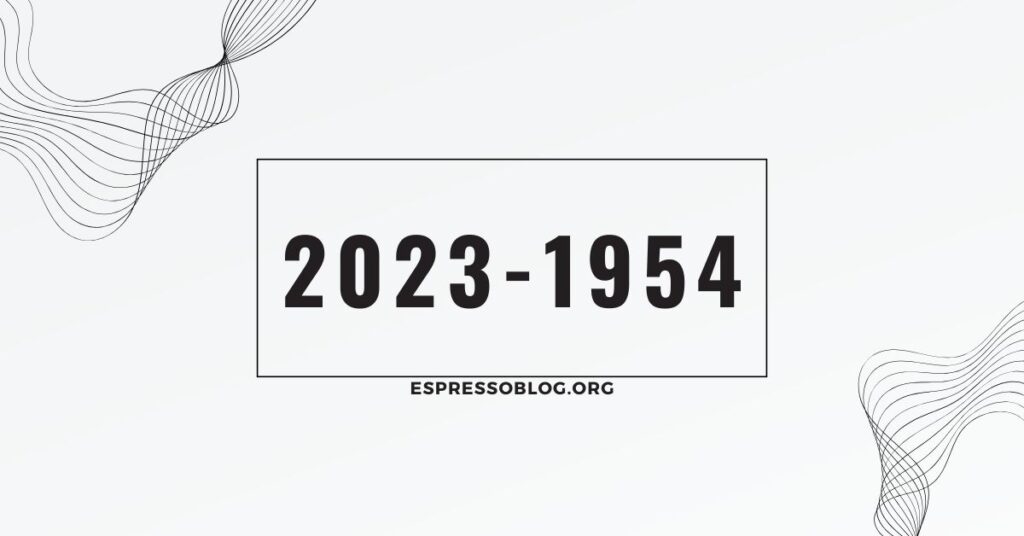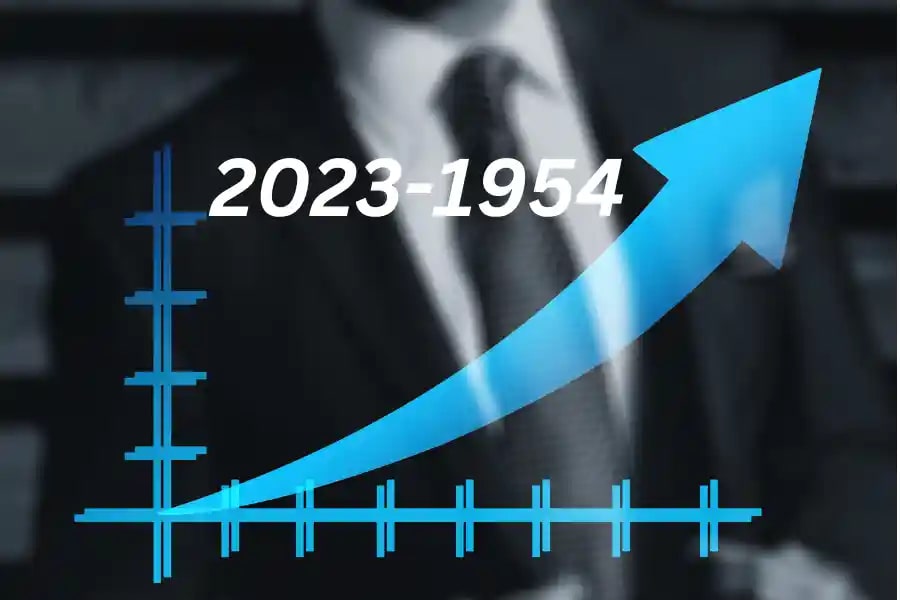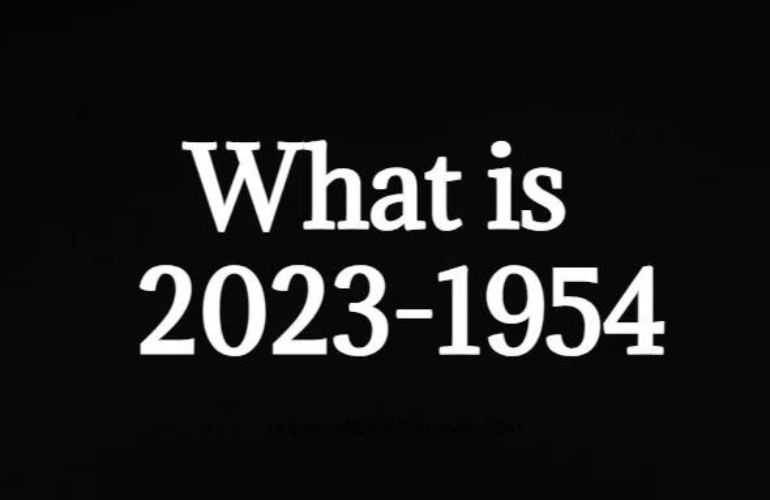
Welcome to a journey where time bends and numbers dance across the ages. In this expansive exploration, we’ll traverse the intricate web of 2023-1954, uncovering its hidden depths and unraveling its mysteries. Join me, as we delve into age calculations, percentage analyses, and the enigmatic FWIB.2023-1954. With our trusty calculators in hand, let’s embark on this odyssey through time and space.
Age Calculation: A Voyage Through Time
Imagine the sands of time slipping through your fingers, each grain representing a year in the vast expanse of your life. If you were born in 1954, the year 2023 might seem like a distant horizon, yet it holds the promise of another milestone on your journey through time.
As we approach the year 2023, you’ll find yourself celebrating your sixty-ninth birthday – a testament to the passage of time and the resilience of the human spirit. Seventy-three years will have spun their intricate web around you, weaving a tapestry of memories, experiences, and wisdom.
Reflecting on this calculation, we’re reminded of the ephemeral nature of existence. Each passing year leaves its mark on our souls, shaping us into the individuals we are destined to become. As you embrace your sixty-ninth year in 2023, take a moment to honor the journey that has brought you here, cherishing every triumph, every setback, and every moment of joy along the way.
Understanding Age Calculation: Cracking the Code
Calculating age may seem like a straightforward task, but beneath its surface lies a wealth of mathematical intricacies waiting to be explored. To determine your age in a specific year, one must navigate the labyrinth of time with precision and clarity.
The formula for calculating age is deceptively simple: subtract your birth year from the desired year. However, like any great puzzle, the devil lies in the details. For instance, consider leap years, where an additional day alters the equation. Calculating age demands attention to detail, ensuring accuracy and reliability in our calculations.
Yet, age is more than just a number; it’s a reflection of our journey through life. It encompasses the laughter shared with loved ones, the tears shed in moments of sorrow, and the lessons learned along the way. As we navigate the complexities of age calculation, let us not lose sight of its profound significance in shaping our understanding of the human experience.
Exploring Percentages: Deciphering the Numbers
Numbers hold within them the power to illuminate the world around us, offering insights into patterns, trends, and relationships. When we encounter a ratio such as 2023/1954, our curiosity is piqued, and we are drawn into the realm of percentages.
To convert a ratio into a percentage, we employ a variety of mathematical tools and techniques. Whether through multiplication or division, percentages allow us to contextualize numerical data, providing a framework for analysis and interpretation.
In the case of 2023/1954, we are presented with a ratio that represents the intersection of two distinct points in time. By converting this ratio into a percentage, we gain a deeper understanding of the relationship between these years, uncovering patterns and trends that may otherwise remain obscured.

Cracking the Code: FWIB.2023-1954 Revealed
Amidst the tapestry of numbers and calculations, a cryptic code emerges – FWIB.2023-1954. But what does it mean, and what secrets does it hold?
FWIB stands for the Future World Interconnectivity Bureau, an organization dedicated to exploring the convergence of past, present, and future. In the context of 2023-1954, FWIB serves as a portal, connecting two distinct epochs in human history.
2023-1954 represents more than just a span of years; it symbolizes the evolution of society, the advancement of technology, and the resilience of the human spirit. By delving into FWIB.2023-1954, we unlock a gateway to the past and a window into the future, offering glimpses of what is yet to come.
A Journey Through Time and Space
As we journey through the convergence of 2023-1954, we are reminded of the interconnectedness of all things. From age calculations to percentage analyses, from cryptic codes to profound revelations, each element we encounter serves as a thread in the intricate tapestry of human experience.
In the end, it is not the numbers themselves that hold significance, but the stories they tell and the insights they offer into the human condition. Whether calculating age, deciphering percentages, or unraveling cryptic codes, our exploration of 2023-1954 is ultimately a journey of self-discovery, a voyage through time and space that illuminates the beauty and complexity of the world around us.
So, let us continue to delve deeper, to ask questions, and to seek answers, for in the convergence of past and future lies the key to unlocking the mysteries of our universe. Together, let us embark on this grand adventure, charting a course through the ever-shifting currents of time and space.
As we bid farewell to the convergence of 2023-1954, let us carry with us the lessons learned and the wisdom gained, for in the tapestry of human history, each moment is but a thread, weaving its way through the fabric of time. And though our journey may come to an end, the adventure continues, as we set our sights on new horizons and embrace the infinite possibilities that lie ahead.
Understanding Age Calculation: A Deeper Dive
The concept of age calculation may appear straightforward at first glance, but beneath its surface lies a complex interplay of mathematical principles and historical contexts. To truly grasp the nuances of age calculation, we must embark on a journey through time, exploring its origins, evolution, and practical applications.
Age, in its simplest form, represents the passage of time since an individual’s birth. However, the calculation of age is not as straightforward as it may seem. Various factors, such as leap years, cultural differences, and calendar systems, can influence the accuracy of age calculations, requiring careful consideration and meticulous attention to detail.
One of the earliest methods of age calculation can be traced back to ancient civilizations, where lunar cycles and celestial movements served as the basis for tracking time. In societies such as ancient Egypt and Mesopotamia, lunar calendars were utilized to determine age and mark significant milestones in the lives of individuals.
As civilizations advanced and developed more sophisticated methods of timekeeping, age calculation became increasingly precise and standardized. The adoption of solar calendars, such as the Gregorian calendar, revolutionized the way age was measured, providing a universal framework that transcended cultural and geographical boundaries.
Today, age calculation relies heavily on the Gregorian calendar, which is based on the Earth’s orbit around the sun and consists of 365 days in a regular year and 366 days in a leap year. By subtracting an individual’s birth year from the current year, one can determine their age with relative accuracy, accounting for leap years when necessary.
However, age calculation is not without its challenges. In some cultures, age is calculated differently, taking into account factors such as the lunar calendar or cultural rites of passage. Additionally, discrepancies in historical records and variations in calendar systems can pose obstacles to accurate age determination, requiring researchers to exercise caution and skepticism when interpreting age-related data.
Despite these challenges, age calculation remains an essential tool for understanding demographic trends, tracking population growth, and assessing the impact of social and economic policies. By accurately determining age, researchers can identify patterns, detect anomalies, and make informed decisions that benefit society as a whole.
As we continue to explore the convergence of past and future, let us not overlook the significance of age calculation in shaping our understanding of the world around us. From ancient civilizations to modern societies, age has served as a fundamental unit of measurement, guiding us on our journey through time and space.
Deciphering Percentages: Unraveling the Mysteries
Percentages, like age calculations, are a fundamental aspect of numerical analysis, providing insights into relationships, trends, and patterns. From financial markets to scientific research, percentages play a crucial role in quantifying data, making comparisons, and drawing conclusions.
At its core, a percentage represents a fraction of a whole expressed as parts per hundred. Whether measuring changes over time, calculating growth rates, or assessing probabilities, percentages offer a standardized method of quantifying numerical data, facilitating comparisons and analyses across different contexts.
When confronted with a percentage problem, one must consider the relationship between the numerator and the denominator, identifying the relevant factors and determining the appropriate method of calculation. Whether using multiplication, division, or other mathematical operations, the goal is to convert the given information into a percentage that accurately reflects the underlying data.
In the case of 2023/1954, we are presented with a ratio that represents the intersection of two distinct points in time. By converting this ratio into a percentage, we gain valuable insights into the relationship between these years, identifying patterns, trends, and changes that may have occurred over time.
However, percentages can be deceptive, masking underlying complexities and nuances that may not be immediately apparent. When interpreting percentage data, one must exercise caution and skepticism, considering the broader context and potential confounding factors that may influence the results.
As we navigate the realm of percentages, let us not lose sight of their limitations and pitfalls. While percentages offer a valuable tool for quantifying data and making comparisons, they are not a panacea, and their interpretation requires careful consideration and critical thinking.
Cracking the Code: FWIB.2023-1954 Revealed
Amidst the tapestry of numbers and calculations, a cryptic code emerges – FWIB.2023-1954. But what does it mean, and what secrets does it hold?
FWIB stands for the Future World Interconnectivity Bureau, an organization dedicated to exploring the convergence of past, present, and future. In the context of 2023-1954, FWIB serves as a portal, connecting two distinct epochs in human history.
2023-1954 represents more than just a span of years; it symbolizes the evolution of society, the advancement of technology, and the resilience of the human spirit. By delving into FWIB.2023-1954, we unlock a gateway to the past and a window into the future, offering glimpses of what is yet to come.
But what secrets does FWIB.2023-1954 hold? What insights can it offer into the mysteries of time and space? As we unravel the enigmatic code, we may discover hidden patterns, cosmic connections, and profound revelations that transcend the boundaries of human understanding.

FAQs
What is the significance of the years 2023 and 1954?
The years 2023 and 1954 hold historical significance in their own right. 1954 marked various events such as the end of the Korean War and the landmark Brown v. Board of Education Supreme Court decision. On the other hand, 2023 represents a future that holds promise and uncertainty, marked by technological advancements and societal changes.
How are age calculations relevant to the convergence of 2023-1954?
Age calculations provide a tangible link between these two years, allowing individuals to understand their journey through time. By calculating one’s age in 2023 based on their birth year in 1954, it becomes apparent how much time has passed and how far individuals have come in their life journey.
What insights can be gained from analyzing percentages related to 2023-1954?
Analyzing percentages related to 2023-1954 can offer insights into various aspects such as population growth, economic changes, and cultural shifts. By understanding the percentage increase or decrease between different data points from 1954 to 2023, researchers can identify trends and patterns that shed light on societal evolution over time.
What is FWIB.2023-1954, and why is it significant?
FWIB.2023-1954 represents a cryptic code that symbolizes the convergence of past and future. It serves as a metaphorical gateway to understanding the interconnectedness of different time periods and the cyclical nature of human history. Deciphering FWIB.2023-1954 can unveil hidden truths and provide insights into the mysteries of time and space.
How can individuals apply the insights gained from studying 2023-1954 in their daily lives?
Understanding the convergence of 2023-1954 can offer individuals valuable perspective on their own lives and the world around them. By reflecting on the historical events of 1954 and contemplating the possibilities of 2023, individuals can gain a deeper appreciation for the passage of time and the interconnectedness of human experiences.
Are there any challenges or limitations to studying the convergence of 2023-1954?
\Yes, there are challenges and limitations to studying the convergence of 2023-1954, including discrepancies in historical records, cultural variations, and the inherent complexities of interpreting data from different time periods. Researchers must exercise caution and skepticism when analyzing data related to 2023-1954 to ensure accuracy and reliability.
What are some potential future implications of studying the convergence of 2023-1954?
Studying the convergence of 2023-1954 can have various future implications, including informing predictions about future trends, guiding policy decisions, and fostering a deeper understanding of human history and civilization. By examining the past and projecting into the future, researchers can gain valuable insights that may help shape a better world for generations to come.

Conclusion
As we journey through the convergence of 2023-1954, we are reminded of the interconnectedness of all things. From age calculations to percentage analyses, from cryptic codes to profound revelations, each element we encounter serves as a thread in the intricate tapestry of human experience.
In the end, it is not the numbers themselves that hold significance, but the stories they tell and the insights they offer into the human condition. Whether calculating age, deciphering percentages, or unraveling cryptic codes, our exploration of 2023-1954 is ultimately a journey of self-discovery, a voyage through time and space that illuminates the beauty and complexity of the world around us.
So, let us continue to delve deeper, to ask questions, and to seek answers, for in the convergence of past and future lies the key to unlocking the mysteries of our universe. Together, let us embark on this grand adventure, charting a course through the ever-shifting currents of time and space.
As we bid farewell to the convergence of 2023-1954, let us carry with us the lessons learned and the wisdom gained, for in the tapestry of human history, each moment is but a thread, weaving its way through the fabric of time. And though our journey may come to an end, the adventure continues, as we set our sights on new horizons and embrace the infinite possibilities that lie ahead.


